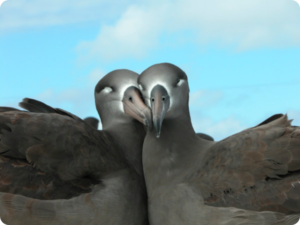Published in the Ocean Watch column, Honolulu Star-Advertiser © Susan Scott
December 05, 2003
Last week, a dream came true: I held an albatross in my arms
I’ve loved these big seabirds since I saw my first ones years ago at Kaena Point. It’s a nature preserve now, but the area was open to off-road vehicles then. The roar of motors drowned out the surf, dirt flew everywhere and the place smelled of exhaust fumes.
And right there in the middle of all this stood several Laysan albatrosses singing and dancing like hippies at a rock concert. Their world was a disaster, but oh well. They danced.
Since then, I’ve had the privilege of seeing probably a million albatrosses in all stages of life. I have watched Laysans untie my shoelaces, and sat motionless while one poked its beak into my gaping pocket. But even with such close encounters, I never touched one.
Since people have shot, hooked, trapped, drowned, tortured and stolen eggs from Hawaii’s albatrosses until their existence is jeopardized, they (and all other seabirds) are protected by state and federal laws.
But besides obeying the law, and giving these birds the peace they deserve, handling them is scary. Albatrosses might not fear people, but that doesn’t mean they like to be picked up. Grab one, especially one of the snappish black-foots, and the big birds will fight for their lives.
Recently, two experienced field biologists arrived here on Tern Island to attach satellite transmitters to selected albatrosses.
“I’m a little nervous about capturing my first black-foot,” one of them told me. Soon after, she was dabbing her bruised, cut and deeply scratched leg with antiseptic. A large male had yanked its beak free of the researcher’s hand, sunk it into her leg and then twisted, all the while kicking like mad.
I remembered this encounter last week when five of us set out to record the band numbers of Tern Island’s nesting black-footed albatrosses. These birds are dying in droves by longliners’ hooks and have recently been listed as an endangered species.
Reading the existing bands was just part of the work. When we found a bird with no number, someone had to pick it up and hold it while another applied a band.
An experienced worker showed me the technique: Hold the beak closed with one hand, and at the same time, sweep the other arm around the bird’s body and scoop it up. The trick is to move smoothly and quickly. To hesitate is to lose.
I was nervous and clumsy, but I finally got my albatross in my arms with beak secured, wings tucked in and feet pointed out. And then I spotted a smear of blood on its foot. “Oh no,” I said, horrified. “It’s bleeding!”
“No, that would be you,” my colleague said, pointing to a scratch on my wrist.
I never thought I’d be happy to see blood oozing from my arm, but that day it was a relief. I hadn’t injured my albatross.
As a fellow worker attached a band to the bird’s leg, I lowered my face to its head, inhaled its ocean smell, and kissed those perfect black feathers, so soft I could barely feel them.
Sometimes when longtime wishes finally come true, they fall short of expectations. Not this time. As I stood there with that magnificent bird in my arms and felt it breathing against my chest, tears sprang to my eyes.
I was holding an albatross.
The below picture is of two black-footed albatrosses Susan took while on Tern Island (courtesy U.S. Fish and Wildlife). This picture has not been altered in any way. They really are this amazing.

Black-footed Albatrosses mated for life.